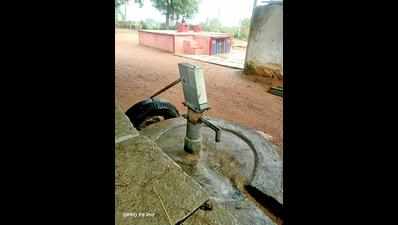- News
- City News
- hubballi News
- Groundwater in 30 villages in Yadgir, Raichur has high arsenic
Trending
This story is from October 24, 2020
Groundwater in 30 villages in Yadgir, Raichur has high arsenic

Samples were mostly collected from the groundwater observation wells/hand pumps in Raichur and Yadgir districts
Hubballi: A study by the Jal Shakti Ministry has lighted upon a disturbing reality: Groundwater in as many as 30 villages in Yadgir and Raichur districts are contaminated with arsenic.
In Kakargal and Maski villages in Raichur district, the concentration of arsenic in groundwater was found to be 0.05mg per litre, which is five times higher than what the World Health Organisation (WHO) deems safe: 0.01mg per litre. The addition of these 30 villages, the groundwater reserves of which are found to contain arsenic, has earned Karnataka the dubious distinction of having most areas where the groundwater has arsenic.Of the 30 villages, 25 are in Raichur and five in Yadgir district.
The Jal Shakti Ministry report has emphasised the imminent need for action to remove this natural element, which is found in rocks and soil in the two districts.
Water samples that were analysed in the course of compiling the report were collected from groundwater observation wells and handpumps. The report has also proffered techniques that can help set right the quality of groundwater reserves in these villages. These include removal of arsenic after extraction of groundwater, locating alternative aquifers for water and diluting the concentration of the contaminants by artificially recharging the aquifers and blending it with potable water.
He pointed to a four-year-old incident in Yadgir district, wherein an entire village had suffered after drinking arsenic-contaminated water. “The government subsequently installed arsenic removal plants in some of the places. But it is not sufficient since the presence of the metal is being found in other places every year,” Mise added.
Sounding an ominous note, Mise sought to remind the government that there was no treatment for metal poisoning. “Water must be stopped at the source itself. Water that people get at the government or private reverse-osmosis (RO) units too must be tested. Boiling the water will not solve the problem. Removing arsenic from water is an expensive affair. Government must look for other sources of water in the affected areas, and it needs to be taken on a war footing. However, arsenic contamination is not a concern when it comes to surface water,” he added.
In Kakargal and Maski villages in Raichur district, the concentration of arsenic in groundwater was found to be 0.05mg per litre, which is five times higher than what the World Health Organisation (WHO) deems safe: 0.01mg per litre. The addition of these 30 villages, the groundwater reserves of which are found to contain arsenic, has earned Karnataka the dubious distinction of having most areas where the groundwater has arsenic.Of the 30 villages, 25 are in Raichur and five in Yadgir district.
The Jal Shakti Ministry report has emphasised the imminent need for action to remove this natural element, which is found in rocks and soil in the two districts.
Water samples that were analysed in the course of compiling the report were collected from groundwater observation wells and handpumps. The report has also proffered techniques that can help set right the quality of groundwater reserves in these villages. These include removal of arsenic after extraction of groundwater, locating alternative aquifers for water and diluting the concentration of the contaminants by artificially recharging the aquifers and blending it with potable water.
Shashikant R Mise, an expert in the field of environmental engineering, stressed the need to raise awareness about groundwater reserves in the region being contaminated with arsenic. “It will have no effect on one’s health if consumed once in a while. But if it is regularly consumed for seven to eight years, it can lead to problems such as skin cancer,” Mise said.
He pointed to a four-year-old incident in Yadgir district, wherein an entire village had suffered after drinking arsenic-contaminated water. “The government subsequently installed arsenic removal plants in some of the places. But it is not sufficient since the presence of the metal is being found in other places every year,” Mise added.
Sounding an ominous note, Mise sought to remind the government that there was no treatment for metal poisoning. “Water must be stopped at the source itself. Water that people get at the government or private reverse-osmosis (RO) units too must be tested. Boiling the water will not solve the problem. Removing arsenic from water is an expensive affair. Government must look for other sources of water in the affected areas, and it needs to be taken on a war footing. However, arsenic contamination is not a concern when it comes to surface water,” he added.
End of Article
FOLLOW US ON SOCIAL MEDIA










